
2015 Dodge Challenger
FIRST DRIVE: 2015 Dodge Challenger
Big-body fun without breaking the bank.
Web2Carz Contributing Writer
Published: July 22nd, 2014
While there's plenty of newness to celebrate with the 2015 Dodge Challenger, including upgrades for both the user experience and the driving experience, everybody only wants to hear about the Hellcat. Yes, it's 707 horsepower; yes, it only (only!) costs $60,000. However, that's not the volume seller; the Hellcat isn't responsible for Challenger's year-over-year sales increases.
The V-6 model is the one flying out the door like crazy, and for good reason; for under $30,000, you can have a car that's comfortable enough to fit a family of four while doing rear-wheel-drive donuts through the Target parking lot.
That's exactly how Dodge (er, Fiat Chrysler Automobiles) markets the Challenger. Since it's roomy enough for four, and since it's about the same price as a well-equipped Toyota Camry, it's touted as being an effective alternative to a more traditional sedan. Now you can be a family man without having to sell your man card! Great, right? Well, sometimes the marketing is just that - mere marketing, all fluff without anything concrete to back it up.
Thankfully (for both Chrysler and its intended market), that's not the case with the 2015 Challenger.
-
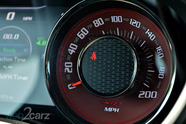
Interior
The biggest changes for 2015 take place inside the Challenger. That's a very good thing, because the pre-2015 Challenger interiors were boring at best, cheap plastic crap at worst. The interior took cues from other new Chrysler vehicles; for example, the non-Hellcat Challengers now have the same steering wheel as the 2015 Chrysler 200. The interior takes a driver-centric approach; nearly every angled surface points something directly at the driver, giving the interior a much more intimate feel.
Given the car's size, the dashboard is simply massive; there's enough space up there to conduct a pre-teen tap-dancing competition. Thankfully, Chrysler received the memo that the public no longer enjoys an interior covered in hard-touch plastics; including the aforementioned ping-pong table doubling as a dashboard, most of the interior is now covered in slightly-less-hard-touch plastics. A Bentley, this ain't.
The worst part about the interior is the cladding for the base-model, non-navigation infotainment system. The screen is smaller than an iPhone's, and it's flanked by eight function buttons. If you've seen both the eight-inch Uconnect screen and the base model in the same car, it's easy to laugh at how pathetic the non-fancy one looks. It almost shames you into opting for navigation - which you should do, because Uconnect is the best system from the Big Three. -
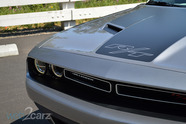
Exterior
This is the one place where much didn't change. The overall shape of the Challenger remains the same, with the largest alterations coming to the front and rear lights. LEDs are now standard fare, and both the rear lights and front grille are now split in twain - a deliberate throwback to the '71 Challengers. The whole front looks a bit more aggressive than before, especially when paired with the downforce-inducing front splitter.
Surprisingly, most of these are inlets are indeed functional, providing much-needed cold air to the various coolers that work hard to prevent the motor from committing seppuku.
On the whole, they didn't change the equation, and that's a good thing. It looks big and angry, which is exactly what the Challenger strives for. -
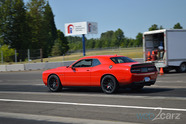
On the Road
During standard driving, the Challenger acts exactly as one would expect a heavy coupe to act. It's never twitchy; its sheer mass keeps the front end pointed in the right direction. That feeling of weight carries over to the handling, although the variable steering does a decent job of masking that heft with quick-ish steering, especially in spirited driving. However, you'll never forget that you're driving a bit of a pig.
That dashboard we mentioned earlier comes into play here. Between the massive dashboard, the chunky A-pillars, and the lengthy hood, sight lines are lacking. That's before you look behind you to see a C-pillar that could double as the side of a house. It's not terribly easy to see out of this car, but that's been a Challenger staple since its inception.
In terms of power, no matter which motor you go with, you'll be happy. There's more than enough gusto from the 3.6-liter Pentastar V-6. However, if you really love a combination of torque and engine noise, we suggest opting for one of the V-8s, be it the 5.7-liter from the R/T or the 6.4-liter from the SRT 392. You won't be let down with any of them ... unless you were looking for gas mileage. It's improved over last year, but in the grand scheme of things, you'll still get to know your Circle K attendant on a first-name basis.
The Hellcat has enough power. Too much for the road, to be honest; that's where the key fobs come into play. If you don't want to use all 707 horsepower at all times, Chrysler is including two key fobs with each Hellcat - a red one and a black one. The black fob only unlocks about 500 horsepower, otherwise known as "more than enough to get to work and back." Switch to the red fob when you're ready to tear things up.
The biggest on-road letdown with the Challenger is the feel of the pedals. The gas pedal is entirely too soft, no matter what mode the car is in, making throttle modulation a little tricky. The brake pedal has decent grab, and it's okay to modulate, but we were hoping for a bit more from the six-pot Brembo calipers on the Hellcat. Carbon ceramics would make a great option - just a thought, FCA. -
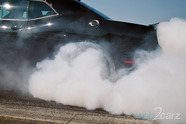
Final Thoughts
Not every Challenger owner will take their car to the track. Those that do, though, will be pleasantly surprised. Yes, the car's weight is its own worst enemy on the track, but if you opt for one of the Super Track Pack packages, it's still plenty of fun. It will keep you striving harder and harder to carry more and more speed into each turn. If you end up with a Hellcat, we'd suggest taking some high-performance driving classes. It's very easy to turn a simple corner into a smoke show when you're sitting on 650 lb-ft of torque, believe it or not.
Of course, most Challenger owners will never see a track, and that's why we only gave it a small mention. Most owners will keep their cars on public roads, choosing instead for the occasional burnout or smoky drift. It succeeds as a muscle car - it's tons of fun, it's fast, and it's good-looking. It even comes with optional creature comforts, like blind-spot assistance and forward collision warning.
Can it work as a replacement for a second family car, or for something to complement the minivan? Absolutely, so long as you don't mind middling gas mileage. However, given the nature of the Challenger, we don't think it's likely to pull many converts from more traditional sports cars. The Corvette, for example, might be down on power compared to the Hellcat, but it's far more competent in lines that aren't straight. Same goes for the BMW M3. Still, it might not convert the more refined drivers out there, but given the Hellcat's insane power-per-pony value, it might have them looking in that direction. -
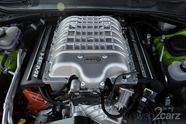
Specs & Prices
Engine: 3.6-liter naturally-aspirated V-6; 5.7-liter naturally-aspirated V-8; 6.4-liter naturally-aspirated V-8; 6.2-liter supercharged V-8
Transmission: Eight-speed automatic, six-speed manual
Drivetrain Layout: Front-engine, rear-wheel drive
Power Output: 305 hp / 268 lb-ft (3.6); 375 hp / 410 lb-ft (5.7); 485 hp / 475 lb-ft (6.4); 707 hp / 650 lb-ft (6.2)
Base Prices: $26,995 (3.6); $31,495 (5.7); $38,495 (6.4); $59,995 (6.2)
• For more information such as specs, prices, and photos of the 2015 Dodge Challenger, click here: 2015 Dodge Challenger.























